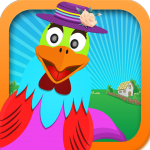 Sky Balloons
Sky Balloons Tipi Tapi Toee
Tipi Tapi Toee Parley Social Hub
Parley Social Hub Chicky Picky Saga
Chicky Picky Saga Beggar Escape
Beggar Escape Snack Reader
Snack Reader Whack Zombies
Whack Zombies Islamic world
Islamic world Bees Spot On
Bees Spot On Dollar Slider
Dollar Slider Sky Ballons Saga
Sky Ballons Saga King Prison Breaker
King Prison Breaker Ice Cream Sticks Artwork
Ice Cream Sticks Artwork Brain Matrix
Brain Matrix Budget Cash & Carry
Budget Cash & Carry Budget Economical
Budget Economical Couch To 5k Warzone
Couch To 5k Warzone Health Tips Weekly
Health Tips Weekly Weight loss Alerts
Weight loss Alerts Romance Alerts
Romance Alerts Dating Alerts
Dating Alerts Flirt Tips
Flirt Tips Gardening Tips
Gardening Tips Love Tips
Love Tips Science Journal
Science Journal Matchstick Artwork
Matchstick Artwork Fuzzle Puzzle
Fuzzle Puzzle Cube Blaster
Cube Blaster Dollar Grabber
Dollar Grabber Moody Mood
Moody Mood
iPads for infants? Parents divided
 Twenty-two-month-old George sits on a tiny blue chair, at a baby-sized desk, playing with a grown-up toy — an iPad, sign of a powerful trend that has set alarm bells ringing among child development experts.
Twenty-two-month-old George sits on a tiny blue chair, at a baby-sized desk, playing with a grown-up toy — an iPad, sign of a powerful trend that has set alarm bells ringing among child development experts.
Leaning over the tablet, the little Parisian finger-stabs the duck icon on “Moo Box”, an application with animal images that let out moos, oinks and barks.
For his mother Aurelie Mercier, 32, the beauty of iPad apps is they can expand her son’s world, like a virtual piano that lets him play music in the absence of the real thing. She even lets her son listen to children music
on the iPad, which she says will help with his imagination and development as he gets older. Using an Ipad can be very educational from a young age. Identifying shapes and colours, being encouraged to talk with kids videos, the list can go on.
Watching this sort of video content at a young age could have some benefits for your children, especially if they are based on education. It could help to give them a headstart when it comes to starting school. Getting to experience how video content works on sites like YouTube, may have inspired your children to start their own channel when they get a little bit older. They could even base it on education to help other young children, just like the videos that they watched helped them. To help build the number of likes they get when they have just begun on this journey, places similar to GetFans can allow them to buy likes so they have a stepping stone to eventually build on. Ipads could open a world of wonders for your children.
“It’s a window onto tons of things that we don’t have at home and that can be condensed into a very small object,” she told AFP.
Fuelled by the likes of George, the number of baby and toddler apps is booming, according to Heather Leister who has reviewed child applications at US website theiphonemom.com since 2009.
But psychologists and parents are divided on putting smartphones and tablets into such young hands, a high-stakes issue considering how pivotal the first couple of years are to child development.
Experts at a panel discussion in New York last month entitled “Baby Brains and Video Games” urged parents to set limits on electronic device use — while acknowledging the magnetic appeal of iPads in particular.
“You can’t pull it from their hands,” said panelist Warren Buckleitner, editor of the Children’s Technology Review.
George, who spends a half hour per week with the iPad, first asked for it at 10 months by pointing and cooing in its direction.
Both graphic artists, his parents recently developed their first app, which generates firework-like images to save as screenshots.
Though geared toward adults, Mercier lets George play with it, talking softly as he sends yellow stars swirling around the screen.
Pervasive culture of video
Now they have seen first-hand what toddlers like — catchy colours, sound, large buttons, simplicity — the pair plan to develop child-friendly apps.
“We’ll use George as our beta-tester,” Mercier said. “We’re counting on him to give good advice!”
For Katie Linendoll, a CNN technology expert in New York, apps are “the ultimate babysitter”. Her favourites for using with her toddler niece — in moderation — include “Crazy Piano!” and “Crayola Color Studio HD”, a high-tech colouring book where animals move once colored.
“If you have an app that’s simple to understand, a kid will run with that,” Linendoll told AFP.
But some parents worry about computer culture interfering with the way their children play with conventional toys.
Sarah Rotman Epps, a Boston-based consumer technology analyst, said her two-year-old son “loves drawing on paper with crayons.
“But he gets very frustrated when the pictures don’t move, and I think that is really coming from the pervasive culture of video and animation.”
In a nutshell: a hit YouTube video dubbed “A Magazine is an iPad that Does Not Work” shows a one-year-old trying in vain to scroll tablet-style through a print publication on her lap.
This is what troubles Paris child psychiatrist Serge Tisseron who worries apps fail to teach children to properly apprehend three-dimensional space, a key developmental milestone.
“We know the toddler absolutely needs to engage all his senses,” he said.
Tisseron is by no means anti-technology — the 64-year-old is himself an avid video gamer — but until more research has been carried out he recommends keeping screens out of baby hands.
In the first two years of life the brain triples in size, synapses forming as young children experiment with objects they sniff, bite and throw.
Despite the iPhone and iPad’s much-lauded interactivity, Tisseron says they remain limited in terms of sensory experience: they can engage sight, hearing and touch — to an extent — but not taste or smell.
That’s where the simplest of toys, and baby games with no set rules, are crucial, says Texas
paediatrician Ari Brown, lead author of a 2011 American Academy of Pediatrics (AAP) report on screen use by children under two.
“There are some pretty good apps and activities that encourage problem solving, memory, ordering, sequencing — virtual versions of games we used to play as kids,” Brown said.
But “no app can replace the value in taking two blocks and figuring out how to stack them one on top of the other.” However, like it’s been said as well as proven with research in various studies you could find online, certain games can be very beneficial for children to learn and develop spatial awareness, mathematics, and other key life skills. An example of a game that many young children can be playing on a PC or iPad can be Minecraft. Minecraft has been used by schools and classes to help create and envision structure design, refine their motor skills, improve their quick mathematics with the counting of blocks, etc. Teachers have even started to host their own private games for their class using minecraft hosting providers, enabling them to create and start an online game on Minecraft that the students will join and partake in some sort of virtual lesson including blocks or one of the many other functions within Minecraft.
— ‘You don’t need technology to play’ —
The AAP discourages passive television viewing in this age group, but the jury is still out on smartphone use, as the technology is so new that long-term research is not yet available. Apple’s app store opened in 2008 and the iPad came out in 2010.
Brown suggests the main danger is a kind of opportunity cost: when youngsters play with iPads, they are not engaged in what may be more beneficial.
That view is shared by Jean-Philippe Vieira, 46, a Paris-area cook who has neither a tablet nor mobile phone and limits his children’s television time to 20 minutes on Friday.
He believes toddlers need space to invent their own games, the way he did growing up in Portugal: “There were moments when we had nothing to do, but that was great because when you do nothing, you come up with ways to occupy yourself.”
“You don’t need technology to play,” Vieira told AFP in a park full of yelling children.
Vieira, whose sons are three, six and eight, cautions against ushering children into a virtual world and is troubled by the idea of parents using the iPad as babysitter.
“Those who want to continue the life they led while single without children, well it’s true these games can be the answer,” he said. “But is it the right answer?”
But for George’s mother Mercier, who never leaves her son unattended with the tablet, there is no harm in moderate use spaced out by other kinds of play.
In their case, keeping tabs on device use meant moving all the screens in their home behind a closed door, an out-of-sight-out-of-mind tactic to keep George from craving technology.
“But seeing as we live in a society with screens everywhere, I don’t think I should keep him from playing with it.”
One Response to iPads for infants? Parents divided
Portfolio
Portfolio
Recent Apps/Games
- How to fix iPhone screen scratches
- Camera of iPhone patent with 3 sensors
- IPhone 7 release date, features
- IPhone 6S (2015), next generation
- Seagate Wireless add your iPhone storage
- Top 5 Workout apps of the week
- Apple watch battery will be replaceable
- Waterproof IPhone maybe the Apple’s next plan
- 5 ways to save your battery
- Icloud design “iwork” to everyone






seo paketleri, seo hizmeti, seo satın al
seo paketleri, seo hizmeti, seo satın al
seo paketleri, seo hizmeti, seo satın al